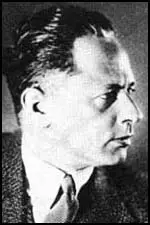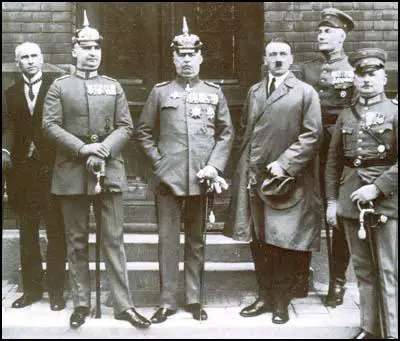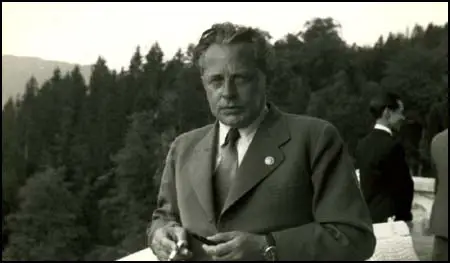Heinrich Hoffmann

Heinrich Hoffmann, the son of a successful photographer, was born in Fürth, Germany on 12th September, 1885. After leaving school he worked in his father's photography shop. He married Therese Baumann, an actress, and on 3rd February, 1913, she gave birth to Henriette Hoffmann.
Hoffmann joined the German Army where he worked as an official photographer during the First World War. In 1919 he published his first book of photographs, A Year of Bavarian Revolution.
In 1920 Hoffmann joined the National Socialist German Workers Party (NSDAP) and soon became a close friend of Adolf Hitler. He became Hitler's official photographer and travelled with him everywhere. William L. Shirer said his "loyalty was doglike".
According to Louis L. Snyder: "Hoffmann's personal and political relationship with Hitler began in Munich in the early days of the National Socialist movement. The photographer, sensing a brilliant future for the budding politician, became his constant companion. For some time he belonged to Hitler's inner circle. Hitler often visited the Hoffmann home in Munich-Bogenhausen, where he felt he could relax from his hectic political life."
Hoffmann was with Hitler at the Beer Hall Putsch and took photographs of the event. On 8th November, 1923, the Bavarian government held a meeting of about 3,000 officials. While Gustav von Kahr, the prime minister of Bavaria was making a speech, Adolf Hitler and armed stormtroopers entering the building. Hitler jumped onto a table, fired two shots in the air and told the audience that the Munich Putsch was taking place and the National Revolution had began.
The next day Hitler, Eric Ludendorff, Hermann Goering and 3,000 armed supporters of the Nazi Party marched through Munich in an attempt to join up with Ernst Roehm and his stormtroopers at the War Ministry At Odensplatz they found the road blocked by the Munich police. As they refused to stop, the police fired into the ground in front of the marchers. The stormtroopers returned the fire and during the next few minutes 21 people were killed and another hundred were wounded, included Goering. Hitler was arrested and received the minimum sentence of five years.

Wilhelm Brückner and Ernst Roehm in 1923. Photograph by Heinrich Hoffmann.
Henriette Hoffmann became a close friend of Hitler's niece, Geli Raubal. Hitler told Otto Wagener: "I can sit next to young women who leave me completely cold. I feel nothing, or they actually irritate me. But a girl like the little Hoffmann or Geli (Raubal) - with them I become cheerful and bright, and if I have listened for an hour to their perhaps silly chatter - or I have only to sit next to them - then I am free of all weariness and listlessness I can go back to work refreshed." According to several sources, Hitler "made a clumsy attempt at some physical contact" with Henriette.
Eva Braun worked as an assistant in Hoffmann's studio. In 1932 Eva met Adolf Hitler. Eva later told her sister: "I'd stayed on after closing time to file some papers and I'd climbed up a ladder to fetch the files kept on the top shelves of the cupboard. At that moment the boss came in accompanied by a man of uncertain age with a funny moustache, a light-coloured, English-style overcoat and a big felt hat in his hand. They both sat down on the other side of the room, opposite me. I tried to squint in their direction without appearing to turn round and sensed that this character was looking at my legs... That very day I'd shortened my skirt, and I felt slightly embarrassed because I wasn't sure I'd got the hem even." Hoffmann sent her out to buy beer and sausages, and then invited Eva to join them: "The elderly gentleman (Hitler) was paying me compliments. We talked about music and a play at the Staatstheater, as I remember, with him devouring me with his eyes all the time. Then, as it was getting late, I rushed off. I refused an offer of a lift in his Mercedes. Just think what Papa's reaction would have been!"
At the time Hitler was romantically attached to Geli Raubal, the daughter of his half-sister, Angela Raubal. Hitler, who had now turned forty, became infatuated with Geli and rumours soon spread that he was having an affair with his young niece. Hitler became extremely possessive and Emil Maurice, his chauffeur, who also showed interest in Geli, was sacked. Although she was 20 years old, she looked very young for her age. Patrick Hitler, Adolf Hitler's nephew, met Geli Raubal during this period: "Geli looks more like a child than a girl. You couldn't call her pretty exactly, but she had great natural charm. She usually went without a hat and wore very plain clothes, pleated skirts and white blouses. No jewellery except a gold swastika given to her by Uncle Adolf, whom she called Uncle Alf."
Anni Winter, Hitler's housekeeper, remembers that Eva Braun was often at Hitler's flat: "Eva Braun was there often when Hitler was in Munich. She was always running after him, insisting on being alone with him. She was a most demanding woman." Cate Haste, the author of Nazi Women (2001) has argued: "From the start, their relationship was conducted in secrecy, not least because Hitler did not want to be associated in public with any one woman. Eva lived at home, and her parents were strict. Hitler, almost totally preoccupied with politics, was rarely in Munich. Eva was kept firmly in the background of his life. The pattern of secrecy that began their relationship suited Hitler, and continued to its end. And so did the pattern of despair. In November 1932, Eva Braun attempted suicide by shooting herself with her father's pistol, but she then rang Hitler's doctor, who came in time to save her, and the whole thing was hushed up. Hitler came to visit her with flowers at the clinic where she was recovering. Eva, the shadowy, loyal figure at the periphery of Hitler's life, continued to be frustrated by his neglect. Hitler would turn up at unpredictable times, and his moods shifted between gushing charm and indifference."
Alan Bullock, the author of Hitler: A Study in Tyranny (1962) has pointed out: "There were several companions who came from the same lower middle class as Hitler himself and with whom he was more at home than with anyone else. Hoffmann, a vulgar, jolly, earthy Bavarian with a weakness for drinking parties and hearty jokes, understood little about politics, but was the one man allowed to photograph Hitler and, long after his friend had become Chancellor and Führer, enjoyed the licence of a court jester."
Heinrich Hoffmann later recalled: "Very occasionally a woman would be admitted to our intimate circle, but she never was allowed to become the centre of it, and had to remain seen but not heard... She could, occasionally, take a small part in the conversation, but never was she allowed to hold forth or to contradict Hitler." This did not change after Hitler began his relationship with Eva Braun: "To him (Hitler) she was just an attractive little thing, in whom, in spite of her inconsequential and feather-brained outlook - or perhaps just because of it - he found the type of relaxation and repose he sought... But never, in voice, look or gesture, did he ever behave in a way that suggested any deeper interest in her."

Hoffmann became very important to Adolf Hitler. As his biographer, Louis L. Snyder, points out: "To this personal friendship was added a profitable business relationship. Much of Hitler's early popularity was due to Hoffmann's superb photography. For some time Hoffmann was the only man permitted to take pictures of the Führer. When Hitler objected to a photographic proof, he knew that Hoffmann would not print it... Hoffmann and Martin Bormann insisted that Hitler's photographs on many postage stamps of different denominations deserved royalties, a decision that led to the accumulation of an enormous fund. The photographer who wagered on the success of the National Socialist movement became a millionaire."
It has been estimated that over the years Hoffmann took over 2.5 million photographs of Hitler. Hoffmann's book, The Hitler Nobody Knows, was published in 1933. Other books on Hitler by Hoffmann included Jugend um Hitler (1934), Hitler in seiner Heimat (1938), Hitler Befreit Sudetenland (1938) and Das Antlitz des Führers (1939). In 1940 Hoffmann was elected to the Reichstag.
Hoffmann was arrested at the end of the Second World War. In 1947 Hoffmann was tried before a West German court as a Nazi profiteer. He was sentenced to ten years' imprisonment and all his wealth with the exception of £3,000 marks was confiscated. Hoffmann eventually served five years in prison. Hoffman also published, Hitler was my Friend (1955).
Heinrich Hoffmann died in Munich on 11th December, 1957.
Primary Sources
(1) Alan Bullock, Hitler: A Study in Tyranny (1962)
There were several companions who came from the same lower middle class as Hitler himself and with whom he was more at home than with anyone else. Hoffmann, a vulgar, jolly, earthy Bavarian with a weakness for drinking parties and hearty jokes, understood little about politics, but was the one man allowed to photograph Hitler and, long after his friend had become Chancellor and Führer, enjoyed the licence of a court jester.
(2) Louis L. Snyder, Encyclopedia of the Third Reich (1995)
Hoffmann's personal and political relationship with Hitler began in Munich in the early days of the National Socialist movement. The photographer, sensing a brilliant future for the budding politician, became his constant companion. For some time he belonged to Hitler's inner circle. Hitler often visited the Hoffmann home in Munich-Bogenhausen, where he felt he could relax from his hectic political life...
To this personal friendship was added a profitable business relationship. Much of Hitler's early popularity was due to Hoffmann's superb photography. For some time Hoffmann was the only man permitted to take pictures of the Führer. When Hitler objected to a photographic proof, he knew that Hoffmann would not print it... Hoffmann and Martin Bormann insisted that Hitler's photographs on many postage stamps of different denominations deserved royalties, a decision that led to the accumulation of an enormous fund. The photographer who wagered on the success of the National Socialist movement became a millionaire.
